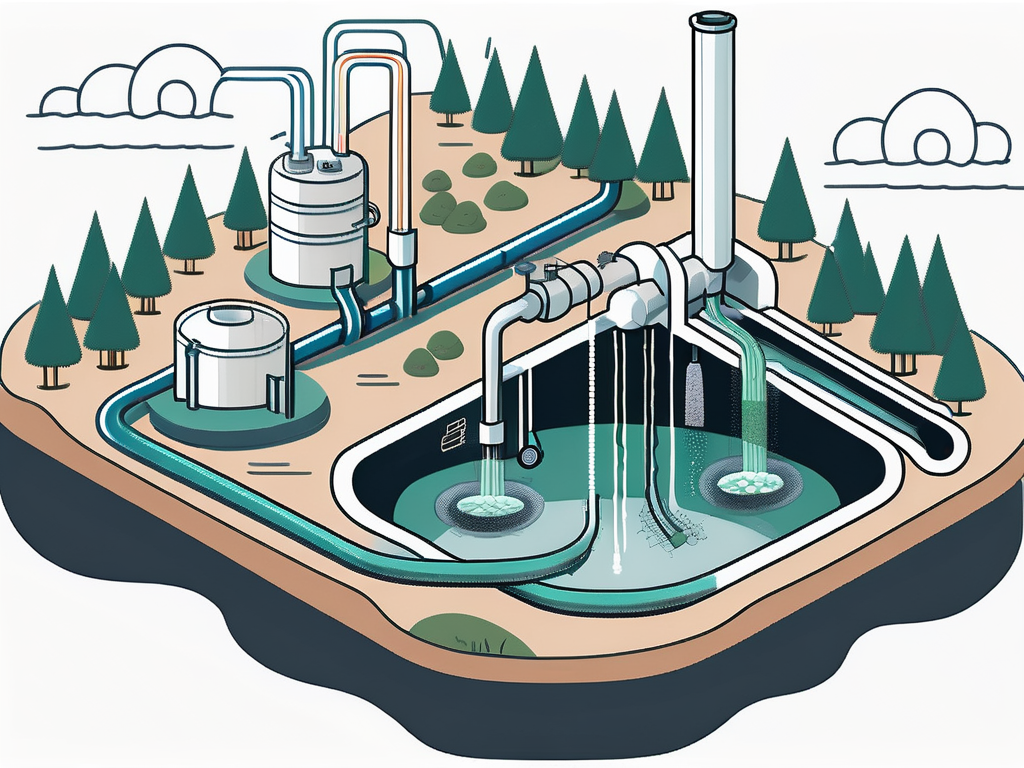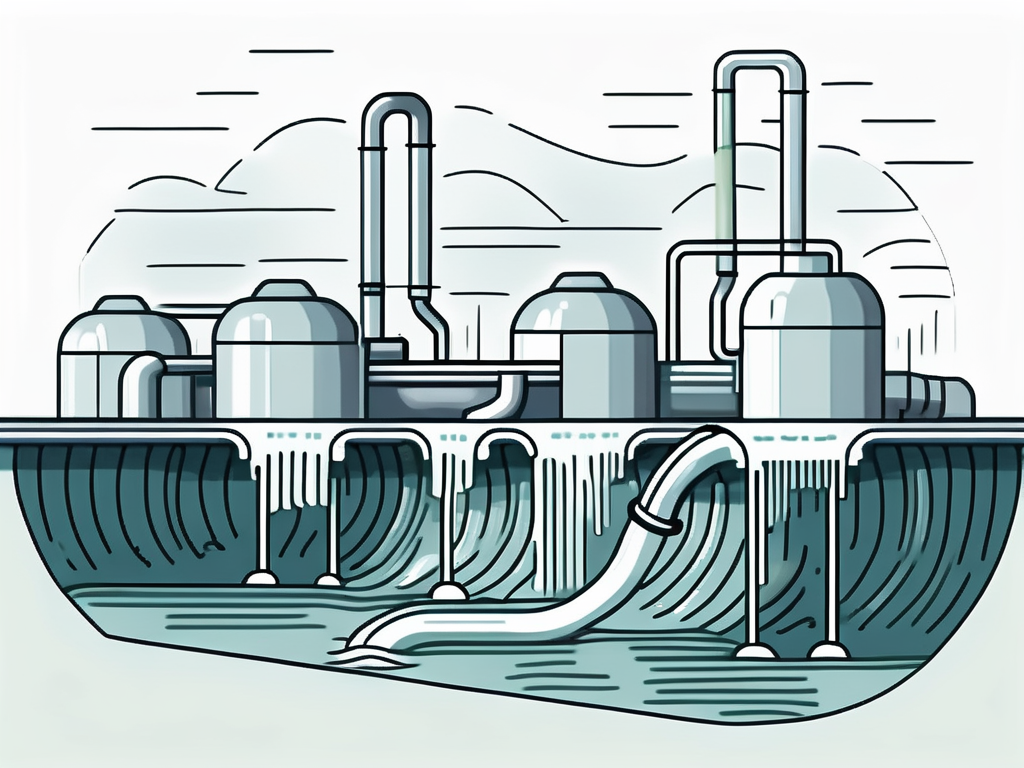
Sanitary Sewer Overflow: Wastewater Treatment Explained
Sanitary Sewer Overflow (SSO) is a condition in which untreated sewage is discharged into the environment prior to reaching sewage treatment facilities. This can occur for a variety of reasons, including blockages, line breaks, sewer defects that allow storm water and groundwater to overload the system, power failures, and inadequate system capacity due to growth. This article will delve into the intricacies of SSOs and wastewater treatment, providing a comprehensive understanding of these critical aspects of public health and environmental protection.
Understanding the causes, impacts, and solutions to SSOs is crucial for anyone involved in wastewater management, environmental protection, and public health. This glossary entry will provide an in-depth look at these aspects, as well as an overview of the wastewater treatment process, which is designed to mitigate the impacts of SSOs and protect our water resources.
Understanding Sanitary Sewer Overflows
Sanitary Sewer Overflows are a significant concern in wastewater management. They occur when the volume of water and waste entering the sewer system exceeds its capacity. This can be due to a variety of factors, including heavy rainfall, blockages in the sewer lines, or equipment failure at the treatment plant. When an SSO occurs, untreated or partially treated wastewater can be discharged into the environment, potentially contaminating water bodies and posing a risk to public health.
SSOs can occur in any part of the sewer system. They are most common in older systems that were not designed to handle the volume of wastewater produced today. In many cases, these systems also suffer from poor maintenance, which can lead to blockages and equipment failures. However, even newer systems can experience SSOs if they are not properly designed, operated, and maintained.
Causes of Sanitary Sewer Overflows
The causes of SSOs are varied and can be broadly categorized into two types: capacity-related and non-capacity-related. Capacity-related causes are those that result from the sewer system's inability to handle the volume of wastewater. This can be due to inadequate design, population growth, or infiltration of stormwater and groundwater into the sewer system.
Non-capacity-related causes are those that result from problems within the sewer system itself. These can include blockages caused by fats, oils, and grease (FOG); tree roots; or other debris. Equipment failures, such as pump failures or power outages, can also lead to SSOs. Finally, structural defects in the sewer lines, such as cracks or breaks, can allow excess water to enter the system and cause an overflow.
Impacts of Sanitary Sewer Overflows
The impacts of SSOs are significant and far-reaching. The most immediate impact is the potential for public health risks. Untreated wastewater contains a variety of pathogens, including bacteria, viruses, and parasites, which can cause diseases such as cholera, dysentery, and hepatitis. People can be exposed to these pathogens through direct contact with the overflow, or indirectly through contaminated water bodies or food.
In addition to the public health risks, SSOs can have severe environmental impacts. The untreated wastewater can contaminate water bodies, leading to the death of aquatic life and the disruption of ecosystems. Nutrients in the wastewater, such as nitrogen and phosphorus, can also cause algal blooms, which can further harm aquatic life and degrade water quality. Finally, SSOs can lead to the closure of beaches and shellfish beds, impacting recreation and local economies.
Wastewater Treatment Process
The wastewater treatment process is designed to remove pollutants from wastewater before it is discharged back into the environment. The process typically involves several stages, including preliminary treatment, primary treatment, secondary treatment, and tertiary treatment. Each stage is designed to remove a specific type of pollutant, and the entire process is carefully monitored and controlled to ensure that the treated wastewater meets regulatory standards.

Wastewater treatment is a complex process that requires a thorough understanding of the characteristics of the wastewater, the types of pollutants present, and the regulatory requirements for discharge. It also requires a well-designed and well-operated treatment plant, and a commitment to regular maintenance and continuous improvement.
Preliminary Treatment
The first stage of the wastewater treatment process is preliminary treatment. This stage is designed to remove large solids and grit from the wastewater. This is typically achieved through screening and grit removal. Screening involves passing the wastewater through screens to remove large objects, such as rags, sticks, and other debris. Grit removal involves settling out sand, gravel, and other heavy particles.
Preliminary treatment is a crucial first step in the wastewater treatment process. By removing large solids and grit, it protects the downstream processes from damage and ensures that they can operate effectively. Without preliminary treatment, large solids and grit could clog pumps and pipes, damage equipment, and interfere with the biological processes used in later stages of treatment.
Primary Treatment
The second stage of the wastewater treatment process is primary treatment. This stage is designed to remove suspended solids and organic matter from the wastewater. This is typically achieved through sedimentation, where the wastewater is held in a tank and the solids are allowed to settle to the bottom. The settled solids, known as sludge, are then removed and treated separately.
Primary treatment is an important step in the wastewater treatment process. By removing suspended solids and organic matter, it reduces the load on the downstream processes and improves the efficiency of the overall treatment process. Without primary treatment, the suspended solids and organic matter could interfere with the biological processes used in later stages of treatment and lead to the discharge of untreated pollutants.
Secondary Treatment
The third stage of the wastewater treatment process is secondary treatment. This stage is designed to remove dissolved organic matter and nutrients from the wastewater. This is typically achieved through biological processes, where microorganisms are used to break down the organic matter and convert the nutrients into forms that can be removed from the wastewater.
Secondary treatment is a critical step in the wastewater treatment process. By removing dissolved organic matter and nutrients, it prevents the discharge of pollutants that can harm aquatic life and degrade water quality. Without secondary treatment, the dissolved organic matter and nutrients could lead to the growth of harmful algae and the depletion of oxygen in water bodies, leading to the death of aquatic life.
Tertiary Treatment
The final stage of the wastewater treatment process is tertiary treatment. This stage is designed to further remove pollutants that were not completely removed during the previous stages. This can include residual organic matter, nutrients, and pathogens. Tertiary treatment can involve a variety of processes, including filtration, disinfection, and advanced oxidation.
Tertiary treatment is an optional step in the wastewater treatment process, and is typically used when the treated wastewater is to be reused or discharged into sensitive water bodies. By providing an additional level of treatment, it ensures that the treated wastewater is of the highest quality and poses minimal risk to public health and the environment.
Preventing and Managing Sanitary Sewer Overflows
Preventing and managing SSOs is a critical aspect of wastewater management. This involves a combination of good design, proper operation and maintenance, and effective response procedures. By taking these steps, wastewater utilities can minimize the occurrence of SSOs and mitigate their impacts when they do occur.
Designing a sewer system to prevent SSOs involves ensuring that the system has sufficient capacity to handle the volume of wastewater, including peak flows during heavy rainfall. It also involves designing the system to minimize the infiltration of stormwater and groundwater, which can overload the system. Finally, it involves providing redundancy in critical components, such as pumps and power supplies, to ensure that the system can continue to operate in the event of a failure.
Operation and Maintenance
Proper operation and maintenance of the sewer system is crucial for preventing SSOs. This involves regular inspections and cleaning of the sewer lines to remove blockages and identify defects. It also involves regular maintenance of the equipment at the treatment plant to ensure that it is operating effectively. Finally, it involves monitoring the flow of wastewater through the system to identify potential problems before they lead to an SSO.
Effective operation and maintenance requires a well-trained and dedicated staff, as well as a commitment to continuous improvement. By regularly reviewing and updating their operation and maintenance practices, wastewater utilities can stay ahead of potential problems and ensure that their systems are operating as efficiently and effectively as possible.
Response Procedures
Despite the best efforts to prevent them, SSOs can still occur. When they do, it's important to have effective response procedures in place to mitigate their impacts. This involves quickly identifying and stopping the overflow, cleaning up the affected area, and notifying the public and regulatory agencies.
Effective response procedures require good communication, both within the utility and with the public and regulatory agencies. By providing timely and accurate information, wastewater utilities can ensure that the public is protected and that the impacts of the SSO are minimized.
Conclusion
Sanitary Sewer Overflows and wastewater treatment are complex topics that involve a wide range of technical, operational, and regulatory considerations. By understanding these aspects, those involved in wastewater management can better protect public health and the environment.

While this glossary entry provides a comprehensive overview of these topics, it is important to remember that each wastewater system is unique, and that the best practices for preventing SSOs and treating wastewater may vary depending on the specific circumstances. Therefore, continuous learning and improvement is crucial for effective wastewater management.



